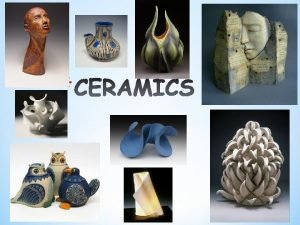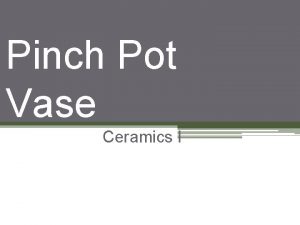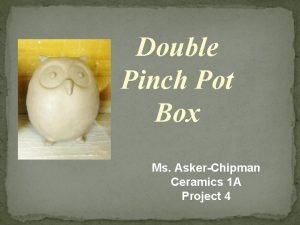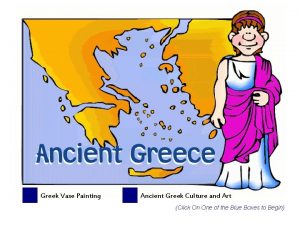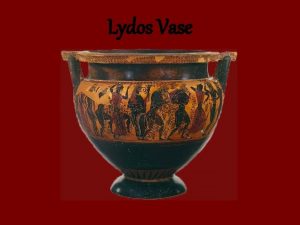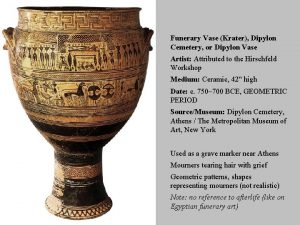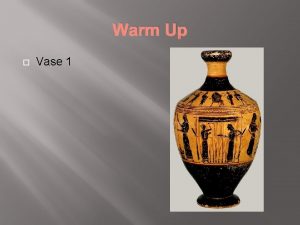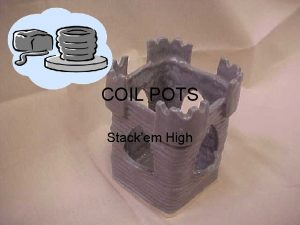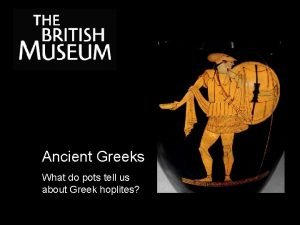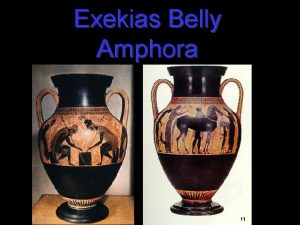GREEK VASE PROJECT Ancient Greek Pots Tell A

















- Slides: 17

GREEK VASE PROJECT

Ancient Greek Pots Tell A Story Greek potters were constantly changing the shape of their famous vases and pots. In ancient Greece, it was not enough to create something that was beautiful. It also had to be comfortable. If the vase, pot, or pitcher had a handle, that handle had to be easy to hold and fit comfortably into the grip of your hand. The Greeks considered themselves scientists as well as artists. Everything had to be perfectly proportioned. The designs on their pottery told a story. Some told stories of daily life. Others told stories of wars and heroes. All designs, whatever they were, had to represent something that people would find pleasing. Geometric designs had to be familiar, a design perhaps that could be found in a temple or a fabric. The colors were soothing and comfortable. Most Greeks were cremated and buried in pots. Even though the pots were to be buried, they still had to be perfect. The ancient Greeks were perfectionists. Archaeologists have discovered a great many ancient Greek pieces of pottery. Between household vases and funeral pots, archaeologists have been able to piece together a great deal of knowledge about daily life in ancient Greece.

GO TO THIS WEBSITE • http: //www. ancientgreece. co. uk/dailylife/explore/pot_shapes. html • In your notes, draw each of the shapes (6 drawings per page), then continue on through the powerpoing and note how each was used.

• Only men were allowed to make pots in Ancient Greece, though women were permitted to paint them. • Pottery was frequently made by slaves. • What survives is often not high art. Really valuable containers tended to be made of bronze, silver or gold. However, little of this survives because the metal was reused. Pottery fragments, having no real value, survive.

Pottery Art • Despite it being a lesser form than metal-craft, some excellent creations exist. • Greek pottery and painting evolved into a significant art form.

Form and Function • Pots were shaped according to their function.

Form & Function • Large storage containers were called amphora and are made with two carrying handles. .

Form and Function • Small storage boxes were called pyxis.

Form and Function • Small vases for perfume or oil were called Alabastron.

Form and Function • Athletes kept their oil supply in small containers called Aryballos

Form and Function • Hydria were used to carry water from wells, springs or rivers.

Form and Function • Kraters were bowls to mix water and wine in.

Form and Function • Wine was ladled from kraters into shallow wine cups called kylix.

Terracotta skyphos (deep drinking cup)

Form and Function • It was also poured directly out of wine jugs called oinochoe.

Form and Function • Lekythos were used to store oil

CREATE A POT • Choose one style of Greek pot. • Sketch it lightly in pencil on a piece of water color paper. • Sketch a Greek-style design on the pot. Remember, nature was particularly important along with the every day lives of people. • Using the oil pastels, trace your pencil designs. Do not color in the designs. • Do a watercolor wash of your drawing. When doing a wash, you use more water than you would normally use when painting. Do not paint small areas with color. This was not done. Choose one color for the
 Greek coil pots
Greek coil pots Exekias achilles and ajax playing a dice game
Exekias achilles and ajax playing a dice game Tell me what you eat and i shall tell you what you are
Tell me what you eat and i shall tell you what you are Show not tell
Show not tell Ancient and modern means of communication
Ancient and modern means of communication Ancient india vs ancient china
Ancient india vs ancient china Pinch pots
Pinch pots Double pinch pot vase
Double pinch pot vase Kitchen safety rule
Kitchen safety rule Clean pots
Clean pots Rds mcas
Rds mcas Double pinch pots
Double pinch pots Knockout pot design
Knockout pot design Polar bear pinch pot
Polar bear pinch pot Pots fracture
Pots fracture There is a person p in my class such that p is
There is a person p in my class such that p is Panda animal pinch pots
Panda animal pinch pots Pinch pots history
Pinch pots history






